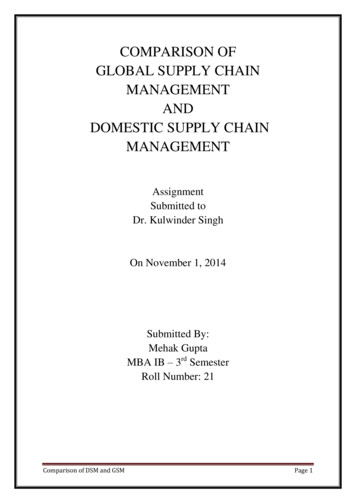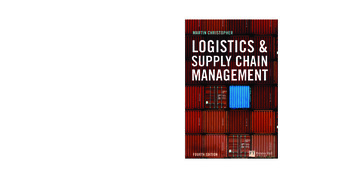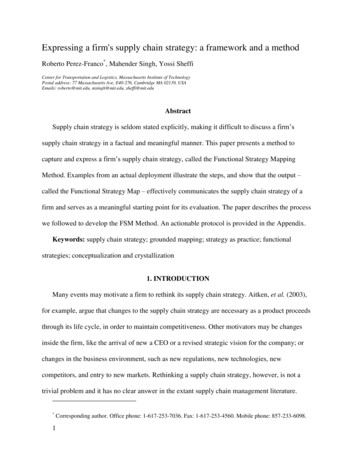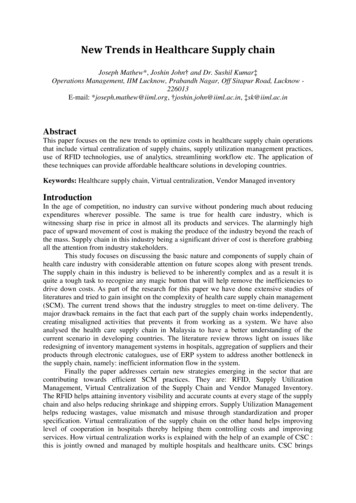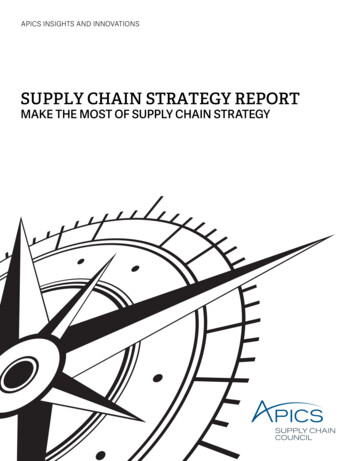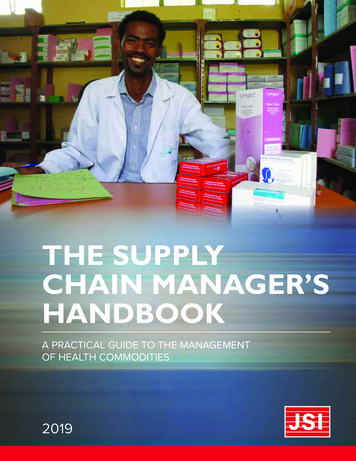
Transcription
THE SUPPLYCHAIN MANAGER’SHANDBOOKA PRACTICAL GUIDE TO THE MANAGEMENTOF HEALTH COMMODITIES2019JS
THE SUPPLY CHAINMANAGER’S HANDBOOKA PRACTICAL GUIDE TO THE MANAGEMENTOF HEALTH COMMODITIESThe authors’ views expressed in this publication do not necessarily reflect the views of the United States Agency forInternational Development or the United States Government.iiTHE SUPPLY CHAIN MANAGER’S HANDBOOK A PRACTICAL GUIDE TO THE MANAGEMENT OF HEALTH COMMODITIES
ABOUT JSIJohn Snow, Inc. (JSI) is a U.S.-based health care consulting firm committed to improving thehealth of individuals and communities worldwide. Our multidisciplinary staff works in partnershipwith host-country experts, organizations, and governments to make quality, accessible healthcare a reality for children, women, and men around the world. JSI’s headquarters are in Boston,Massachusetts, with U.S. offices in Washington, D.C.; Atlanta, Georgia; Burlington, Vermont;Concord, New Hampshire; Denver, Colorado; Providence, Rhode Island; and San Francisco,California. JSI also maintains offices in more than 40 countries throughout the developing world.RECOMMENDED CITATIONJohn Snow, Inc. 2017. The Supply Chain Manager’s Handbook, A Practical Guide to theManagement of Health Commodities. Arlington, Va.: John Snow, Inc.ABSTRACTThe Supply Chain Manager’s Handbook: A Practical Guide to the Management of HealthCommodities is the starting point for anyone interested in learning about and understandingthe key principles and concepts of supply chain management for health commodities. Conceptsdescribed in this handbook will help those responsible for improving, revising, designing,and operating all or part of a supply chain. John Snow, Inc. (JSI) has written The Supply ChainManager’s Handbook based on more than 30 years of experience improving public health supplychains in more than 70 countries.Cover graphic: Photo courtesy of USAID DELIVER ProjectJOHN SNOW, INC.1616 Fort Myer Drive, 16th FloorArlington, VA 22209 USAPhone: 703-528-7474Fax: 703-528-7480Email: jsiinfo@jsi.comInternet: www.jsi.comTHE SUPPLY CHAIN MANAGER’S HANDBOOK A PRACTICAL GUIDE TO THE MANAGEMENT OF HEALTH COMMODITIESiii
TABLE OF CONTENTSACRONYMS.PREFACE.1. INTRODUCTION TO LOGISTICSWhat a Supply Chain Manager Needs to Know. 11.1 What Is Supply Chain Management?. 11.2 Why Supply Chains Matter.31.3 The Supply Chain and the Six Rights. 51.4 The Role of the Supply Chain Manager. 61.5 Logistics Cycle: Organized Logistics Activities. 81.6 Supply Chain Integration.121.7 Supply Chain Evolution-The Path to Integration.151.8 Segmentation in the Public Health Supply Chain Context.162. SUPPLY CHAIN STRATEGY AND DESIGNWhat a Supply Chain Manager Needs to Know.182.1 National Supply Chain Strategy (or master plan).182.2 System design.203. INFORMATION SYSTEMS FOR DATA VISIBILITY AND USEWhat a Supply Chain Manager Needs to Know.253.1 What is a Logistic Management Information System?.263.2 Data Selection.303.3 Data collection. 333.4 Data visibility. 343.5 Digital LMIS.363.6 Data Use.393.7 Data Quality. 414. PRODUCT SELECTIONWhat a Supply Chain Manager Needs to Know. 434.1 Purpose of Product Selection. 444.2 National Essential Medicines List.46ivTHE SUPPLY CHAIN MANAGER’S HANDBOOK A PRACTICAL GUIDE TO THE MANAGEMENT OF HEALTH COMMODITIES
4.3 Registration of Pharmaceutical Products. 474.4 Standard Treatment Guidelines. 484.5 Funder Requirements.494.6 Laboratory Supplies and Equipment Standardization.505. QUANTIFICATION OF HEALTH COMMODITIESWhat a Supply Chain Manager Needs to Know. 535.1 Introduction to Quantification.545.2 Key Steps in Quantification.555.3 Using the Quantification Results. 725.4 Reviewing and Updating the Quantification. 736. HEALTH COMMODITY PROCUREMENTWhat a Supply Chain Manager Needs to Know. 756.1 The Complexity and Challenges of Procurement. 766.2 Developing the Procurement Strategy. 78 6.3 Steps in Procurement (Focus on Competitive Tendering). 877. INVENTORY STRATEGYWhat a Supply Chain Manager Needs to Know.937.1 Purposes of Holding Inventory.947.2 Considerations for Defining an Inventory Strategy.957.3 Defining and Implementing the Inventory Strategy.987.4 Inventory Control System and Policies . 1017.5 Monitoring and Measuring Inventory Performance. 1048. WAREHOUSING AND DISTRIBUTIONWhat a Supply Chain Manager Needs to Know. 1098.1 Warehousing. 1108.2 Distribution. 1198.3 Outsourcing. 1228.4 Performance Measurement.1238.5 Health and Safety.1249. PERFORMANCE MANAGEMENTWhat a Supply Chain Manager Needs to Know.131THE SUPPLY CHAIN MANAGER’S HANDBOOK A PRACTICAL GUIDE TO THE MANAGEMENT OF HEALTH COMMODITIESv
9.1 What is Performance Management?.1329.2 Creating Performance Management Systems.1339.3 Key Performance Indicators.13510. ORGANIZATIONAL CAPACITY AND WORKFORCEWhat a Supply Chain Manager Needs to Know.13910.1 Introduction. 14010.2 Staffing the Supply Chain.14110.3 Building the Capacity of the Supply Chain Workforce. 14610.4 Supporting Your Greatest Asset, the Workers on the Job. 14910.5 Providing Stewardship and Leading the Supply Chain Team.15310.6 Monitoring Workforce Performance. 15611. FINANCINGWhat a Supply Chain Manager Needs to Know.16311.1 Tracking Commodity Financial Flows. 16411.2 Supply Chain Costing. 16911.3 Economic Evaluation.17312. SUPPLY CHAIN RISK MANAGEMENTWhat a Supply Chain Manager Needs to Know.17812.1 Risk Management Basics.17912.2 Benefits of Risk Management. 18012.3 Risk Management as a Formal Process forPublic Health Supply Chain Managers. 181ADDENDUM.SUPPLY CHAIN MANAGEMENT FOR HEALTHCAREIN HUMANITARIAN RESPONSE SETTINGSWhat a Supply Chain Manager Needs to Know. 189 Distinctions between health care supply chain management forhumanitarian response and stable development contexts. 190 General practices for supply chain management of healthcommodities within humanitarian response phases. 194Overview of phases of humanitarian response. 195Recommended Practices.197viTHE SUPPLY CHAIN MANAGER’S HANDBOOK A PRACTICAL GUIDE TO THE MANAGEMENT OF HEALTH COMMODITIES
FIGURESFigure 1-1: Correlation Between Contraceptive Prevalence Rate and Product Availability.4Figure 1-2: Correlation Between Malaria Mortality Rates and Product Availability.4Figure 1-3: Logistics Cycle. 8Figure 1-4: The Integrated Public Health Supply Chain. 13Figure 1-5: Supply Chain Evolution.15Figure 2-1: Logistics Cycle. 17Figure 2-2: Timeline of Master Planning Activities in a West African Country .19Figure 2-3: Supply Chain System Design Process.21Figure 3-1: Logistics Cycle.25Figure 3-2: The Role of data in Supply Change Evolution.26Figure 3-3: Sample LMIS Information and Supply Flow Diagram. 27Figure 3-4: Sample Logistics Reporting System for National Vaccine Program. 35Figure 3-5: Data Entry Screen for Requisitions for HCMIS Ethiopia.36Figure 3-6: Vaccine Dashboard for vLMIS Pakistan. 37Figure 3-7: Dashboard of Stock Status by Location and Product for eLMIS Tanzania. 38Figure 3-8: Managing the Process of Developing a Digital LMIS.30Figure 4-1 Logistics Cycle. 43Figure 4-2: Applying Value Analysis in Product Selection.45Figure 5-1: Logistics Cycle. 53Figure 5-2: Steps in Quantification.55Figure 5-3: Sample Forecasting Tree for Zinc Tablets for Treatmentof Diarrhea in Children Under 5 .64Figure 6-1: Logistics Cycle. 75Figure 6-2: Supply Positioning Matrix. 83Figure 6-3: Procurement Steps. 87Figure 7-1: Logistics Cycle.93Figure 7-2: Network Diagram.96THE SUPPLY CHAIN MANAGER’S HANDBOOK A PRACTICAL GUIDE TO THE MANAGEMENT OF HEALTH COMMODITIESvii
Figure 7-3: Safety Stock and Service Level Relationship. 97Figure 7-4: Segmenting Inventory. 100Figure 8-1: Logistics Cycle. 109Figure 8-2: Warehouse De-Junking. 118Figure 8-3: Basic Distribution Center Model. 120Figure 8-4: Basic Distribution Network Model. 121Figure 9-1: Logistics Cycle.131Figure 9-2: Performance Management Cycle Graphic.133Figure 10-1: Logistics Cycle.139Figure 10-2: Impact of Human Resources on Supply Chain Performance. 140Figure 10-3: Recruit the Right People. 146Figure 10-4: Building the Capacity of your Supply Chain Workforce.147Figure 10-5: Professionalization of Supply Chain. 152Figure 10-6: Regions Using QIT Approach Show Improvement inKey Supply Chain Indicators. 155Figure 10-7: PBF Intervention Decision Tree.157Figure 11-1: Logistics Cycle.163Figure 11-2: Steps for Counting and Tracking Commodity Funding. 165Figure 11-3: Country Example of Commodity Financing. 166Figure 11-4: Comparison of Requirements, Commitments, and Spending.167Figure 11-5: Typical Financing Process Steps. 168Figure 11-6: Supporting Health Services with Effective Supply Chain. 169Figure 11-7: Supply Chain Costing Framework.171Figure 11-8: Supply Chain Costs.172Figure 11-9: Components of Economic Evaluation of Supply Chains.173Figure 12-1: Logistics Cycle. 177Figure 12-2: Supply Chain Risk Management Process. 181Figure 13-1: Phases of Humanitarian Response. 195viiiTHE SUPPLY CHAIN MANAGER’S HANDBOOK A PRACTICAL GUIDE TO THE MANAGEMENT OF HEALTH COMMODITIES
TABLESTable 2-1: Type of Data Collected (Illustrative).22Table 3-1: HMIS and LMIS Differences.30Table 3-2: Essential Logistics Data Items. 32Table 5-1: Preparation Process.56Table 5-2: Forecasting Process.58Table 5-3: Types and Sources of Data for Forecasting Product Consumption.60Table 5-4: Example Country Data Quality Analysis for ARV Drug Quantification.62Table 5-5: Conversion of Data into Product Quantities.66Table 5-6: Supply Planning Process.68Table 5-7: Supply Planning Data Requirements.69Table 11-1: Zambia: Cost Effectiveness of AlternativeEssential Medicines Supply Chains.175Table 11-2: Supply Chain Risk Management Process.Table 12-1: Common Conceptions vs. Best Practice inSupply Chain Risk Management .179Table 12-2: Example of Scale Interpretations for Impact of Risk Events.183Table 12-3: Example of Scale Interpretations for Likelihood of Risk Events.183Table 12-4: Example Solutions for Risks to CommodityAvailability at the Service Delivery Point. 185ANNEXAnnex 3-1: Sample Business Process Map for Order Processing Function. 42Annex 8-1: Storage Guidelines.126Annex 8-2: Common Product Quality Problems. 129Annex 8-4: Common Product Quality Problems.130Annex 10-1: Supervision Checklist for Health Facility Visits.THE SUPPLY CHAIN MANAGER’S HANDBOOK A PRACTICAL GUIDE TO THE MANAGEMENT OF HEALTH COMMODITIESix
ACRONYMSx3PLThird party logistics provider3TCLamivudine (antiretroviral drug)ABCAbstinence, be faithful, use condomsACTArtemisinin-based combination therapyAIDSAcquired immune deficiency syndromeAMRHAfrican Medicines Regulatory HarmonizationAPIActive pharmaceutical ingredientAPICSAmerican Production and Inventory Control SocietyAPSAdvance planning systemsARTAntiretroviral therapyARVAntiretroviralCBACost-benefit analysisCEACost-effectiveness analysiscGMPCurrent Good Manufacturing PracticeCHWCommunity health workerCMSCentral Medical StoresCOGSCost of goods soldCOOCertificate of originCPRContraceptive prevalence rateCSCMPCouncil of Supply Chain Management ProfessionalsCYPCouple-years of protectionDDesirable drugs (inventory strategy)DALYDisability-adjusted life yearsDfIDUK Department for International DevelopmentDHSDemographics and Health SurveyDPTDiphtheria-tetanus-pertussis vaccineEEssential drugs (inventory strategy)ECHOEuropean Commission’s Civil Protection and Humanitarian Aid OperationsEFVEfavirenz (antiretroviral drug)ELISAEnzyme-linked immunosorbent assayeLMISElectronic LMISEMLEssential medicines listEMRElectronic medical recordTHE SUPPLY CHAIN MANAGER’S HANDBOOK A PRACTICAL GUIDE TO THE MANAGEMENT OF HEALTH COMMODITIES
EOQEconomic order quantityERPEnterprise resource planningFBOFaith-Based OrganizationsFIFOFirst-in, first-outGCPGood clinical practiceGDPGood distribution practiceGFATMGlobal Fund to Fight AIDS, Tuberculosis and MalariaGISGeographic information systemGLPGood laboratory practiceGMPGood manufacturing practiceGPSGlobal Positioning SystemGSPGood storage practiceHISHealth information systemHIVHuman immunodeficiency virusHMISHealth management information systemsHRHuman ResourcesHSSHealth Sector StrategyHNOHumanitarian Needs OverviewIAPHLAssociation of Public Health LogisticiansIASCInter-Agency Standing CommitteeICCInventory control cardsICTInformation and communications technologyIMPACTInformation Mobilized for Performance Analysisand Continuous Transformation NetworkINNInternational non-proprietary nameITInformation TechnologyIUDIntrauterine deviceJSIJohn Snow, Inc.KPIKey performance indicatorsLAMLactational amenorrheaLIATLogistics Indicators Assessment ToolLMISLogistics management information systemsLMULogistics Management UnitLSATLogistics System Assessment ToolM&EMonitoring and evaluationTHE SUPPLY CHAIN MANAGER’S HANDBOOK A PRACTICAL GUIDE TO THE MANAGEMENT OF HEALTH COMMODITIESxi
xiiMAPEMean absolute percent errorMISManagement information systemMOHMinistry of HealthMOHSWMinistry of Health and Social WelfareMQASModel quality assurance standardsMRPMaterials requirements planningMSMedical storesMSHMedicines and Health TechnologiesNNecessary drugs (inventory strategy)NDRANational drug regulatory authorityNEMLNational essential medicines listNGONongovernmental organizationNVPNevirapine (antiretroviral drug)OCHAOffice for Coordination of Humanitarian AffairsOFDAOffice of Foreign Disaster AssistanceOJTOn-the-job trainingPATHProgram for Appropriate Technology in HealthPBIPerformance based incentivePEPFARPresident’s Emergency Plan for AIDS ReliefPOPurchase orderPODProof of deliveryPOSPoint-of-servicePtDPeople that DeliverRFEOIRequest for Expression of InterestRFIRequest for InformationRFPRequest for proposalsRFQRequest for quotesRIRVRequisition, issue, and receipt voucherROIReturn on investmentSC4CCMSupply Chains for Community Case ManagementSCMSSupply Chain Management SystemSCORSupply Chain Operations ReferenceSDPService delivery pointSKUStock keeping unitSMARTSpecific, measurable, attainable, realistic, and timelySOHStock on handTHE SUPPLY CHAIN MANAGER’S HANDBOOK A PRACTICAL GUIDE TO THE MANAGEMENT OF HEALTH COMMODITIES
SOPStandard operating procedureSPARHCSStrategic Pathway to Reproductive Health Commodity SecuritySRAStringent regulatory authoritySRC(Chapter 10)ST&CSpecific Terms and ConditionsSTGStandard treatment guidelinesSTISexually transmitted infectionTBTuberculosisTCOTotal cost of ownershipTDFTenofovir disoproxil fumarate (antiretroviral drug)TFRTotal fertility rateTMSTransport management systemTOTTraining-of-trainersTRACThe Risk Assessment and ControlUNUnited NationsUNDACUN Disaster Assessment and CoordinationUNDPUnited Nations Development ProgrammeUNDP-CIPSUnited Nations Development Programme Chartered Institute of Procurement and SupplyUNFPAUnited Nations Population FundUNHCRUN High Commission for RefugeesUNHRDUN Humanitarian Resource DepotsUNICEFU.S. Agency for International DevelopmentUSAIDUnited States Agency for International DevelopmentVVital drugs (inventory strategy)VANVisibility and Analytics NetworksVEDVital, essential, and desirableVENVital, essential, and nonessentialVMIVendor-managed inventoryVPPVoluntary Pooled ProcurementVVMVaccine vial monitorWFPWorld Food ProgramWHOWorld Health OrganizationWHO PQWorld Health Organization PrequalifiedWIWork instructionWMSWarehouse management systemTHE SUPPLY CHAIN MANAGER’S HANDBOOK A PRACTICAL GUIDE TO THE MANAGEMENT OF HEALTH COMMODITIESxiii
PREFACEStrong systems save lives. Strong supply chains are critical to get health products to clients,wherever and whenever they need them. The Supply Chain Manager’s Handbook is thestarting point for anyone interested in learning about and understanding the key principles andconcepts of supply chain management for health commodities. The handbook will be valuablefor anyone involved in managing, operating, or overseeing health commodity supply chains, frompolicymakers and program managers, to service providers, storekeepers, technical assistanceproviders, and public- and private-sector partners. Concepts described in this handbook willhelp those responsible for improving, revising, designing, and operating all or part of a supplychain. The technical topics apply to managing a variety of health commodities, including essentialmedicines, antiretroviral medicines, vaccines, contraceptives, antimalarial medicines, diagnostics,tuberculosis medicines, and laboratory commodities.John Snow, Inc. assembled some of our most experienced supply chain experts to write TheSupply Chain Manager’s Handbook based on more than 30 years of experience improving publichealth supply chains in more than 70 countries. We have worked together with gover
ii THE SUPPLY CHAIN MANAGER’S HANDBOOK A PRACTICAL GUIDE TO THE MANAGEMENT OF HEALTH COMMODITIES THE SUPPLY CHAIN MANAGER’S HANDBOOK A PRACTICAL GUIDE TO THE MANAGEMENT OF HEALTH COMMODITIES. JOHN SNOW, INC. . Figure 3-2: The Role of data in Supply



